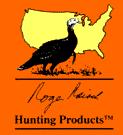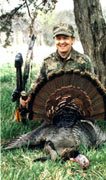Finding Turkeys
Copyright © 1998 - 2021 Roger
W. Raisch * Nadine Adele, all rights reserved
|
Finding gobblers in
the spring is easy, if you do some pre-season scouting. Prior
to season, on any quiet, sunny, nice day, gobblers will sound off in the morning before
flying down even if you don't torment them into gobbling with Locator Calls.
Pre-season scouting is essential in remote
areas of large, continuous forest tracts. In habitat that is mixed with agricultural
crops and forest, turkeys should be easy to locate with binoculars and a spotting scope
and by listening for gobbling.
In large forested areas, turkey populations
are usually not high, turkeys may be scattered in the spring, and not every timbered ridge
will have a gobbler.
If the terrain is mountainous and access poor,
it's doubly important to be on the right ridge at daybreak. If you aren't you may
hear birds gobbling on a nearby ridge, but have no way to get across a deep ravine or
hollow in time.
Even where woodlots are small and scattered,
it may be difficult to move between them after sunrise without spooking turkeys.
Knowing where turkeys are before you hit the woods in the morning is the SECRET.
|
The most important
thing to learn from pre-season scouting is the terrain, and how it affects turkey
movements.
Excited gobblers are reluctant to cross
fences, deep hollows and streams that pose no problems for them at other times.
I have had many frustrating encounters with
turkeys that would not cross fences. I would hear lots of gobbling, but couldn't get
birds to come through them.
A good topographic map is a valuable aid if
you're not intimately familiar with the area. Gobblers may move quite a distance
from their winter range, so sightings just before and during the season are the most
useful.
|
Once you know the
terrain, visit with landowners, foresters, conservation officers, local and regional
biologists about where they see turkeys.
My experience is that landowners are
your best source for specific information. Usually the government employees are
hunters too and won't provide anything but general information.
|
The knowledge gained during a couple
weekends scouting prior to the season can be a big help. Listen
for gobbling in your chosen area at daybreak but stay in the area all morning.
Stay on the ridgetops so you can hear
farther. Listen for gobbling as birds move around during the day.
Sit patiently in places where you can observe
good feeding areas and Strut Zones
with your binoculars and spotting scope.
Note the number and sex of the turkeys you see
in these areas and observe how and where they enter these spots and where they exit.
Their movements are not totally predictable, but you will pick up some locations that are
preferred at different times of the day.
Check roost sites after
turkeys have left. Look for feathers, droppings, tracks and
scratchings.
Plot all information on your topo map and
refer to it when you hunt. With your scouting information plotted from year to year,
patterns of activity will develop that indicate where birds are likely to be at any time
of the day.
|
Don't forget about
scouting during the season too.
In states where afternoon hunting is not
permitted, go to the woods about mid-afternoon and stay until dark.
Watch and listen without being seen and you'll
find even more turkeys than you thought were in your woods.
Cruise the woods on foot and drive back roads
using a spotting scope to locate even more turkeys.
|
Spring turkeys aren't hard
to find, but it takes some gas and shoe leather to do it...but well worth the effort. |
| top ^ |
| |
t

God Bless America
|
View
Cart & Check-Out
DECEMBER
2025
877.267.3877
515.299.5388
24 / 7
WE answer
our
phones Personally!
|
|












